Vienna Philharmonic Silver Coins: An Overview
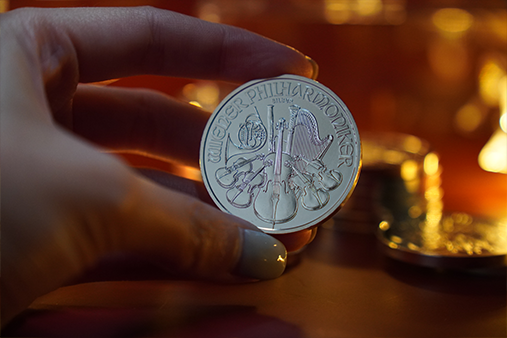
Introduction
Vienna Philharmonic Silver Coins are among the most popular bullion coins available in the market today. The Vienna Philharmonic coins are produced by the Austrian Mint and are the only European bullion coins with a face values in euros.
This article will explore the history and significance of Vienna Philharmonic Silver Coins. We will also discuss the coin's design, the various sizes available, and the advantages of investing in these coins.
History of Vienna Philharmonic Coins
Minting in the region of Austria dates back all the way to the Roman Empire and even back to the Celts. One notable milestone in Austrian coin minting history occurred in 1194 when Richard the Lionheart, King of England, was held captive in Austria. To secure his release, a hefty ransom was demanded, which was partially paid in silver from the Austrian mines. This event marked the beginning of silver mining and coin minting in the region of Tyrol, which would become a significant center of coin production in later centuries.
Over the centuries, the Austrian Mint, also known as Münze Österreich, played a prominent role in coin minting. It was officially established in 1328 and became the sole authority for coin production within the Habsburg Empire. The mint produced coins of various denominations and metals, including gold, silver, and copper.
The Vienna Philharmonic Orchestra is one of the most renowned orchestras in the world. The Austrian Mint decided to honor this orchestra by creating the Vienna Philharmonic coin series featuring the orchestra on the obverse side. The Vienna Philharmonic Silver Coin was first introduced in February of 2008 as a silver version of the well-established Vienna Philharmonic Gold Coins, which had been in production since 1989 and even became the best-selling gold coin in the world for three years. The silver coins were created after the gold coin to meet the increasing demand for investment-grade silver bullion.
From 2008 to 2012, the Silver Philharmonic witnessed strong sales, reaching over five million coins sold, equivalent to 1,800 tons of silver. While the Vienna Philharmonic is the sole European bullion coin denominated in euros, it holds legal tender status solely in Austria.
Design of Vienna Philharmonic Silver Coins

Thomas Pesendorfer initially designed the silver coin for the gold Vienna Philharmonic issued in 1989. In 2008, the Austrian Mint introduced the silver version with an unchanged design, which has remained consistent each year.
The obverse side has the German words "REPUBLIK ÖSTERREICH" (Republic of Austria) and displays the pipe organ from Vienna's Musikverein's Golden Hall, home to the Vienna Philharmonic Orchestra. The reverse design showcases a selection of musical instruments, including a harp, violins, a cello, a bassoon, and a Vienna horn.
The selection of the Vienna Philharmonic to be featured on the gold and silver coins was a tribute to its musical excellence, cultural significance, and contribution to Austria's artistic heritage, while also serving as a means to promote and commemorate the esteemed orchestra on a global scale.
While the Vienna Philharmonic gold coins are minted with a reeded edge, the silver version of the coin has a smooth edge. The gold bullion coins are packaged in sets of 10 inside plastic tubes, while the silver bullion coins come in tubes of 20 and are stored in larger "monster boxes" containing 500 coins each.
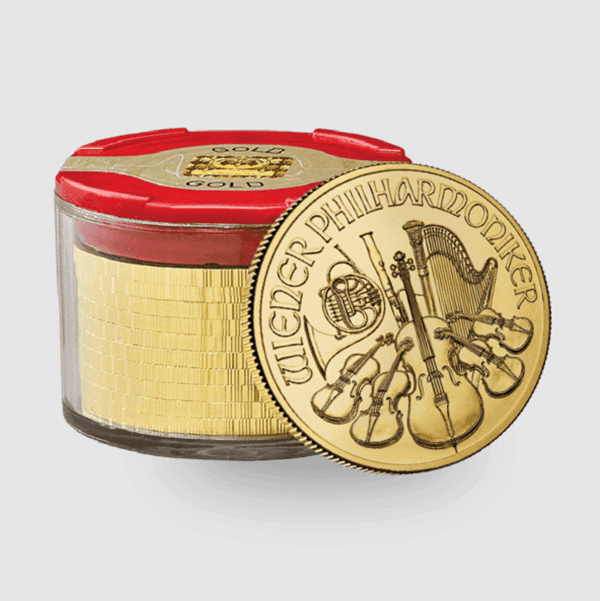
A 10-piece tube of Vienna Philharmonic gold coins
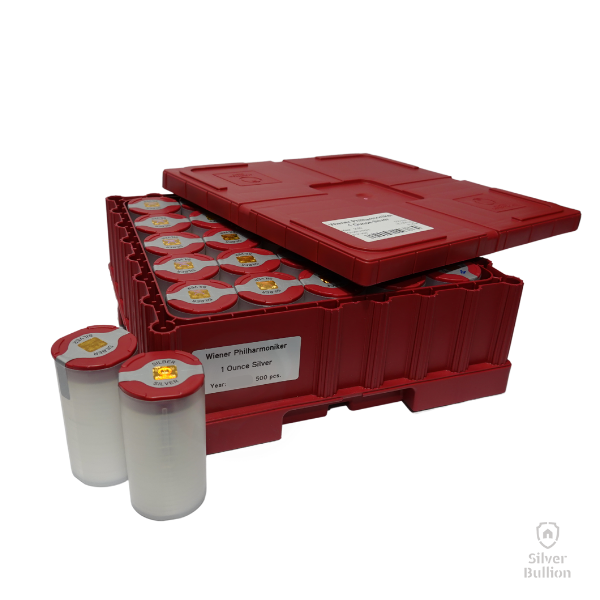
Vienna Philharmonic silver coin tubes and "monster box"
Purity & Sizes of Vienna Philharmonic Silver Coins
The Austrian Silver Philharmonic coins mainly consist of one troy ounce of silver bullion, with a fineness of .999 (99.9% pure silver). With a face value of €1.50 and, a diameter of 37 mm, and measuring 3.2 mm in thickness, this coin is legal tender in Austria.
Investing in Vienna Philharmonic Silver Coins
Vienna Philharmonic Silver Coins are an excellent investment choice for several reasons. First, they are backed by the Austrian government, which gives them a level of security and stability. Second, they are minted in .999 fine silver, which means they are a pure investment in silver. Finally, they are available in various sizes, which makes them accessible to investors with different budgets.
Philharmonic silver coins rank among the world's top investment-grade coins. Alongside other popular silver coins like US Silver Eagles, Canadian Silver Maple Leafs, British Silver Britannia, and Chinese Silver Panda, the philharmonic coin enjoys widespread recognition. Its popularity ensures liquidity when selling, an important aspect of bullion investing. Austrian Philharmonic silver coins are tax-exempt in Canada, with reasonable premiums. Keeping costs in check is crucial for investors, making it essential to choose cost-effective bullion options.
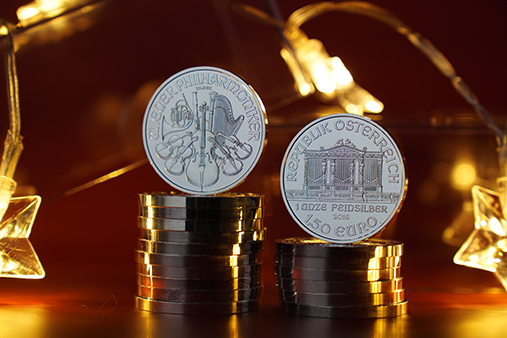
Advantages of Investing in Vienna Philharmonic Silver Coins
Vienna Philharmonic Silver Coins offer several advantages to investors. First, they are a safe and stable investment, backed by the Austrian government. Second, they are a pure investment in silver, which makes them an excellent hedge against inflation. Finally, they are highly liquid, which means they can be easily bought or sold.
Storage and Care for Vienna Philharmonic Silver Coins
Properly storing and caring for your Vienna Philharmonic silver coins is essential to maintain their condition and value. Here are some key guidelines to follow:
Handle the coins with clean, lint-free gloves or by their edges to prevent fingerprints and oils from damaging the surfaces. Store them in a clean, dry environment away from excessive humidity, direct sunlight, extreme temperatures, and airborne pollutants. Avoid exposure to moisture and chemicals, as these can cause tarnishing and discoloration.
To protect each coin individually, use protective holders or capsules designed specifically for coins. Avoid holders with PVC, as it can react with silver and cause damage. Choose PVC-free materials like Mylar flips or coin tubes for long-term storage.
Consider using airtight plastic tubes or coin storage boxes to further safeguard your coins and maintain organization. Minimize handling and exposure to air to prevent oxidation and accidental damage. These coins should be kept in a cool, dry place away from direct sunlight and humidity.
Ensure your valuable coin collection is adequately insured against loss, theft, or damage. Additionally, maintain detailed documentation, including the coins' condition, purchase dates, and any certifications they may have.
Selling Vienna Philharmonic Silver Coins
Vienna Philharmonic Silver Coins can be sold easily, either through a bullion dealer or an online marketplace. It's important to research the current market value of the coins before selling them to ensure a fair price. Selling to a reputable dealer can also ensure a safe and smooth transaction.
Counterfeits and how to avoid them
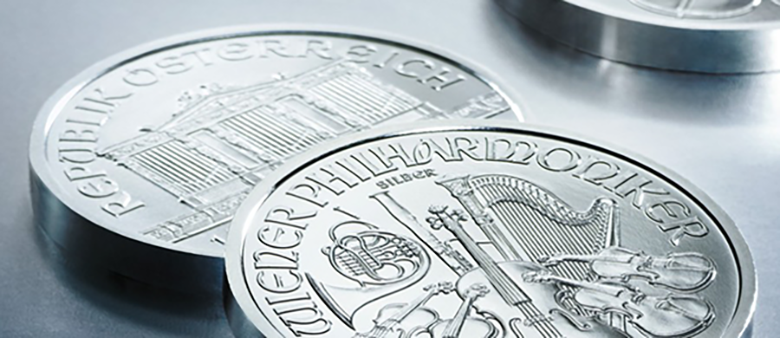
As with any popular investment, Vienna Philharmonic Silver Coins are also a target for counterfeiters. It's important to purchase these coins from a reputable dealer to avoid counterfeit coins. Counterfeit coins can be identified through various methods, such as weight, size, and design. It's recommended to do research on identifying counterfeit coins before purchasing.
Whereas the Vienna gold philharmonic coins have reeds around the coin, the silver coin has a smooth edge finish surrounding the coin in order to differentiate between the two in texture.
Where to buy Vienna Philharmonic Silver Coins
Vienna Philharmonic Silver Coins can be purchased from various sources, including bullion dealers, online marketplaces, and the Austrian Mint. It's important to research the seller's reputation and the current market value of the coins before making a purchase.
Collecting Vienna Philharmonic Silver Coins
Vienna Philharmonic Silver Coins are not only an excellent investment choice but also a popular choice among collectors. Collectors often seek out specific designs or years of issues to complete their collections. Collecting Vienna Philharmonic Silver Coins can be a fulfilling hobby and investment opportunity.
Future Outlook for Vienna Philharmonic Silver Coins
The future outlook for Vienna Philharmonic Silver Coins remains positive. The coins have been a popular choice among investors and collectors since their introduction in 2008. As long as silver remains a valuable investment, Vienna Philharmonic Silver Coins will likely continue to be a sought-after choice.
Conclusion
Vienna Philharmonic Silver Coins are an excellent investment choice for those looking to invest in silver. These coins are backed by the Austrian government, minted in .999 fine silver, and available in various sizes. They also offer a beautiful design, making them a popular choice among collectors. By taking care of these coins properly and purchasing from reputable dealers, investors and collectors can enjoy the benefits of Vienna Philharmonic Silver Coins for years to come.
